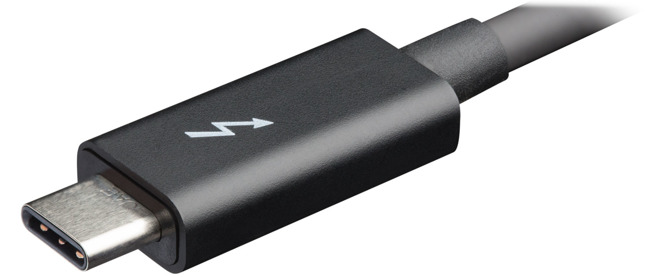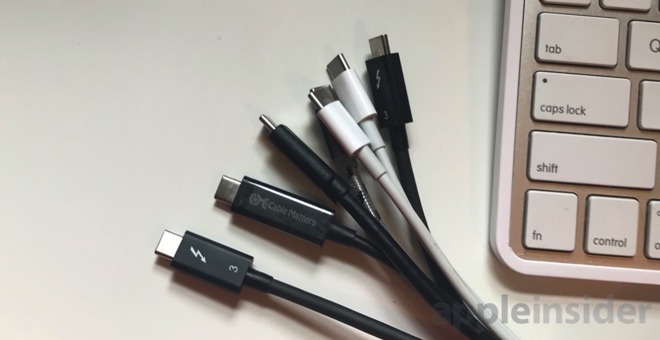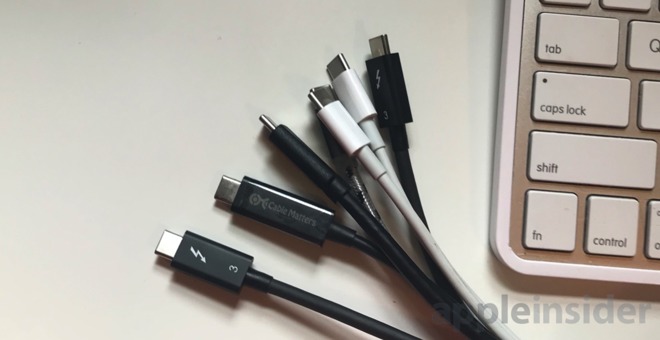PSA: Thunderbolt 3 cables longer than 0.5m generally don't support USB 3.1 speeds
USB-C is the future of computer connectivity, but there is a great deal of confusion over USB-C, Thunderbolt 3, USB 3.1, and what any given cable with USB-C connectors is capable of. AppleInsider breaks it all down.

Apple introduced USB-C to its user base with the retina 12-inch MacBook. At the time, it was a fancy USB port limited to USB 3.0 speeds of 5Gbit per second, and was officially called USB 3.1 Type-C Generation 1.
The same physical port was used in the 2016 MacBook Pro refresh, offering a faster, more capable Thunderbolt 3 port with the same USB-C physical connector. The Thunderbolt 3 protocol allows for 40Gbit per second -- assuming the cabling for it is right.
But, right now, confusion reigns -- and a simple choice that Apple made in the 2016 MacBook Pro is making it worse.
Thunderbolt 3 at 40Gbit per second has to be USB-C at both ends. USB 3.1 at 5Gbit per second or 10Gbit per second does not. Both share the same physical USB-C connector for the host device.

Seven USB-C cables, seven different specs -- which is which?
Complicating matters somewhat, a Thunderbolt 3 cable can function as a USB 3.1 cable -- but not all can. A USB 3.1 cable with USB-C is never a Thunderbolt 3 cable.
Also, not every USB-C cable -- be it Thunderbolt 3 or USB 3.1 Type-C -- is capable of 100W allowed in the specification. In fact, many fall far short.
A 15-inch MacBook Pro cable is rated for 87W when plugged into the appropriate MacBook Pro adapter. It can be used on the MacBook and 13-inch MacBook Pro at appropriate wattage.
The converse is true, but the combination will only supply charging power of the lowest rated component, be it cable or AC adapter. For example, an 87W power adapter with a 60W-rated cable will only provide 60W to the host computer.
Simple enough. But, the Apple-supplied cable is only capable of USB 2.0 speeds, and is in no way a Thunderbolt 3 cable.
So, that's a problem. We get around that with careful sorting -- but admittedly a surplus of Thunderbolt 3 cables isn't a common problem.
Most Thunderbolt 3 accessories come with 18-inch cables, but in our experience they are mostly useless. Users shopping for longer cables aren't being greeted with universal language, or with complete specifications in every case.
Short, passive Thunderbolt 3 cables, such as those packed-in with docks, are very nearly always fully compatible with USB 3.1 type-C peripherals. But, like we said, the length isn't that handy.
Thunderbolt 3 runs longer than 18-inches can be passive or active. The passive ones have lower speed, with the max data rate hitting about 20Gbit/second at two meters of cable length.
However, active cables contain transceivers to regulate the data transfer through the cable. At the same two meters, speed is still at the maximum of 40Gbit/second.
Passive cables maintain USB 3.1 type-C compatibility. Active ones do not.
There is no correlation between passive or active, and maximum wattage.

In the above picture, left to right: 2 meter 60W active Thunderbolt 3 cable, 2 meter 100W active thunderbolt cable, 2 meter 60W passive Thunderbolt 3, 2 meter 60W USB 3.1 Type-C cable, 2 meter 60W USB 2.0-speed Type-C Apple charging, 2 meter 87W USB 2.0-speed Type-C Apple charging, and a 0.5 meter passive 100W Thunderbolt 3 cable capable of 40Gbps. All of the markings on each cable are shown in the picture.
It's not much better shopping for Thunderbolt 3 cables on Amazon. The industry needs to settle on a common marking scheme for power, data rates, and passive or active -- and it has not as of yet.
CalDigit has one way to label cables, and Belkin has another.
Looking for the data rate isn't enough when shopping for Thunderbolt 3. Searching on 40Gbps doesn't tell you if the cable is passive or active.
The reviews for cable listings on Amazon are a tale of poor labeling, and a lack of customer clarity. Some users complain that the Thunderbolt 3 cable won't work on their printer. Others claim that the USB-C cable won't provide enough power.
As a result of the complaints the listings have cleared up some making the hunt easier -- once you've decided what you need.
Here at AppleInsider, we've settled on two brands of long, active, Thunderbolt 3 cables: the 60W Cable Matters 6.6-foot and 100W CalDigit 1 meter and 2 meter cables. They aren't cheap -- but SCSI veterans and FireWire users know where we're coming from regarding that. We willingly sacrifice USB 3.1 Type-C compatibility to guarantee that we're getting max bandwidth to our docks and eGPUs.
Hard drives, even most RAID arrays we've examined, aren't so demanding. Passive, long cables, such as that from Plugable at 20Gbps, work fine. They also work with USB 3.1 Type-C printers, and other accessories.
USB 3.1 Type-C cables are far less demanding. We have no specific recommendation for them -- but do be mindful of maximum power limitations if you're going to charge a 15-inch MacBook Pro.
As a quick cheat-sheet: Active Thunderbolt 3 cables are high-speed but expensive, and lack USB 3.1 Type-C compatibility. Passive Thunderbolt 3 cables are generally short for best performance, and maintain USB 3.1 Type-C compatibility. Neither passive nor active imply anything about maximum charging power, nor are they necessarily labeled on the cable indicating what they are capable of.
And, if you just need USB 3.1 Type C, just get that. Don't pay the premium for Thunderbolt 3. Be mindful of wattage, though.
But, regardless of what you buy, come up with your own solution for labeling what's what, and what it can do. It'll save you time in the long run.

Apple introduced USB-C to its user base with the retina 12-inch MacBook. At the time, it was a fancy USB port limited to USB 3.0 speeds of 5Gbit per second, and was officially called USB 3.1 Type-C Generation 1.
The same physical port was used in the 2016 MacBook Pro refresh, offering a faster, more capable Thunderbolt 3 port with the same USB-C physical connector. The Thunderbolt 3 protocol allows for 40Gbit per second -- assuming the cabling for it is right.
But, right now, confusion reigns -- and a simple choice that Apple made in the 2016 MacBook Pro is making it worse.
USB-C versus USB 3.1 versus Thunderbolt 3
Put simply, USB-C as a term by itself means nothing about data speed or charging ability -- it's only a description of the physical connector.Thunderbolt 3 at 40Gbit per second has to be USB-C at both ends. USB 3.1 at 5Gbit per second or 10Gbit per second does not. Both share the same physical USB-C connector for the host device.

Seven USB-C cables, seven different specs -- which is which?
Complicating matters somewhat, a Thunderbolt 3 cable can function as a USB 3.1 cable -- but not all can. A USB 3.1 cable with USB-C is never a Thunderbolt 3 cable.
Also, not every USB-C cable -- be it Thunderbolt 3 or USB 3.1 Type-C -- is capable of 100W allowed in the specification. In fact, many fall far short.
Where Apple's choice fits in
With the 2016 and 2017 MacBook Pro, Apple has included a USB-C charging cable. Depending on model, the cable is either capable of 27W, 60W or 87W at maximum.A 15-inch MacBook Pro cable is rated for 87W when plugged into the appropriate MacBook Pro adapter. It can be used on the MacBook and 13-inch MacBook Pro at appropriate wattage.
The converse is true, but the combination will only supply charging power of the lowest rated component, be it cable or AC adapter. For example, an 87W power adapter with a 60W-rated cable will only provide 60W to the host computer.
Simple enough. But, the Apple-supplied cable is only capable of USB 2.0 speeds, and is in no way a Thunderbolt 3 cable.
Enter, confusion
We've had a pile of very short Thunderbolt 3 cables pass through the testing lab while we've gone through the docks and other Thunderbolt 3 peripherals. They're not all clearly labeled. Some are capable of even 100W. Some aren't.So, that's a problem. We get around that with careful sorting -- but admittedly a surplus of Thunderbolt 3 cables isn't a common problem.
Most Thunderbolt 3 accessories come with 18-inch cables, but in our experience they are mostly useless. Users shopping for longer cables aren't being greeted with universal language, or with complete specifications in every case.
Short versus long, passive versus active
The short cables that come with docks and other peripherals are called passive cables. To keep costs down they are no-frills cables, and because of it, runs longer than 18 inches have slow transfer speeds for connected devices. This can cause problems in high-bandwidth situations like docks or the LG 5K Ultrafine display.Short, passive Thunderbolt 3 cables, such as those packed-in with docks, are very nearly always fully compatible with USB 3.1 type-C peripherals. But, like we said, the length isn't that handy.
Thunderbolt 3 runs longer than 18-inches can be passive or active. The passive ones have lower speed, with the max data rate hitting about 20Gbit/second at two meters of cable length.
However, active cables contain transceivers to regulate the data transfer through the cable. At the same two meters, speed is still at the maximum of 40Gbit/second.
Passive cables maintain USB 3.1 type-C compatibility. Active ones do not.
There is no correlation between passive or active, and maximum wattage.
Choose wisely...
We presented a picture earlier in this article. Here it is again.
In the above picture, left to right: 2 meter 60W active Thunderbolt 3 cable, 2 meter 100W active thunderbolt cable, 2 meter 60W passive Thunderbolt 3, 2 meter 60W USB 3.1 Type-C cable, 2 meter 60W USB 2.0-speed Type-C Apple charging, 2 meter 87W USB 2.0-speed Type-C Apple charging, and a 0.5 meter passive 100W Thunderbolt 3 cable capable of 40Gbps. All of the markings on each cable are shown in the picture.
It's not much better shopping for Thunderbolt 3 cables on Amazon. The industry needs to settle on a common marking scheme for power, data rates, and passive or active -- and it has not as of yet.
CalDigit has one way to label cables, and Belkin has another.
Looking for the data rate isn't enough when shopping for Thunderbolt 3. Searching on 40Gbps doesn't tell you if the cable is passive or active.
The reviews for cable listings on Amazon are a tale of poor labeling, and a lack of customer clarity. Some users complain that the Thunderbolt 3 cable won't work on their printer. Others claim that the USB-C cable won't provide enough power.
As a result of the complaints the listings have cleared up some making the hunt easier -- once you've decided what you need.
Here at AppleInsider, we've settled on two brands of long, active, Thunderbolt 3 cables: the 60W Cable Matters 6.6-foot and 100W CalDigit 1 meter and 2 meter cables. They aren't cheap -- but SCSI veterans and FireWire users know where we're coming from regarding that. We willingly sacrifice USB 3.1 Type-C compatibility to guarantee that we're getting max bandwidth to our docks and eGPUs.
Hard drives, even most RAID arrays we've examined, aren't so demanding. Passive, long cables, such as that from Plugable at 20Gbps, work fine. They also work with USB 3.1 Type-C printers, and other accessories.
USB 3.1 Type-C cables are far less demanding. We have no specific recommendation for them -- but do be mindful of maximum power limitations if you're going to charge a 15-inch MacBook Pro.
As a quick cheat-sheet: Active Thunderbolt 3 cables are high-speed but expensive, and lack USB 3.1 Type-C compatibility. Passive Thunderbolt 3 cables are generally short for best performance, and maintain USB 3.1 Type-C compatibility. Neither passive nor active imply anything about maximum charging power, nor are they necessarily labeled on the cable indicating what they are capable of.
And, if you just need USB 3.1 Type C, just get that. Don't pay the premium for Thunderbolt 3. Be mindful of wattage, though.
But, regardless of what you buy, come up with your own solution for labeling what's what, and what it can do. It'll save you time in the long run.

Comments
there are also glass fiber Thunderbolt cables that have 40Gbs for long lengths, but they are even more expensive. Corning and Intel make them.
The glass fiber Thunderbolt cables are TB2 cables and 20Gbps. The TB3 versions aren't available.
In testing I've done, even a 2 drive striped RAID of conventional 7200RPM 5TB hard drives have effectively identical real-world performance through Thunderbolt 3 or USB 3.1 type-C. In theory, massive, sequential transfers could saturate USB 3.1 type-C but that very rarely ever happens.
We'll look into it more at some point in the future.
My problem is that the manufacturers of cables and adapters don't give any indication of power output on the packaging.
You count on something sold as a Thunderbolt 3 cable as being capable of TB3 speeds, and I guess for the most part that's correct. Most cables will say somewhere on the packaging what the data rate is. And Belkin at least label whether the cable will support 4K or 5K diplays. But even in detailed specs on the back of the box, they don't always list power throughput.
For instance, I found a USB-C HDMI adapter with USB-C passthrough, USB-A, and an HDMI port. The packaging says "Supports Power Delivery", but nowhere does it say at what power. Checking the vendor website, I got even less information than was on the box (power delivery wasn't even mentioned). I'm guessing, based on price at least, that it is at most as capable as Apple's Digital Multiport Adapter, which is only to 60W (or was last I checked - Apple should get on that), so it's not sufficiently powerful for my needs. (Actually, it's not that big a deal, I have a USB-C to DVI adapter that works fine without any pass-through at all, let alone power delivery.)
I'm fine with them not having indications on the cables, although it shouldn't be too hard for them to implement that, but not being able to tell before I buy something whether it will support my equipment is kind of a problem. (I can keep track of which cables have which sets of features myself, or at least I'm willing to accept responsibility for doing so, even if I forget.)
I'm most likely wrong here but I thought Apple's USB-C to USB-C cables (that come with MacBooks/Pro) are Thunderbolt 3 cables with USB3.1 gen2 speed? Thanks
The Belkin TB3 dock was recently reviewed, and ships with a 3.3ft TB3 cable, while the dock advertises 40Gbps performance and 85W charging. So what is the included cable's actual speed, power, and active/passive specs? I know this dock with its included TB3 cable is compatible with a 2017 MacBook Pro 13", and not (backward) compatible with a 2015 MacBook 12".
It feels like the 'universal' in USB-C doesn't mean anything anymore. Not only are cables with a USB-C connector unclear about their speed, power, and active/passive specs, but the TB3 docks are proprietary. A Belkin TB3 dock only works with the MacBook Pro, while a Dell TB3 dock only works with the Dell laptop, etc...
When TB3 was announced, I mistakenly looked forward to a day when I could buy one TB3 dock and it would 'universally' dock with and power (up to 100W) any TB3 computer from Apple, Dell, Panasonic, and others. Not anymore.
The problem with this, is there's no universality to it. A 2 meter cable doesn't have to be active. An 18-inch cable doesn't have to be passive -- but most of the cables packed into docks are. Cable length is not a deterrent to power delivery - that's up to the manufacturer.
The only firm detail is an Active cable will provide 40Gbps at any length, where a passive cable only delivers it to about 24 inches. There are no other relations.